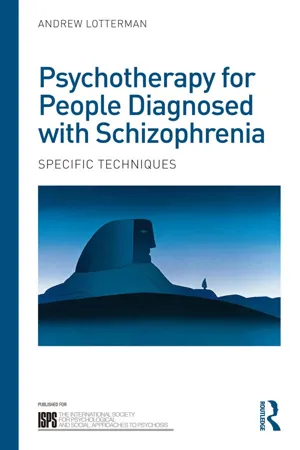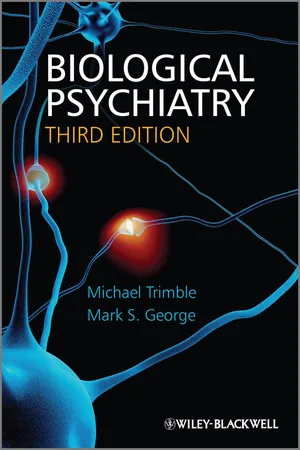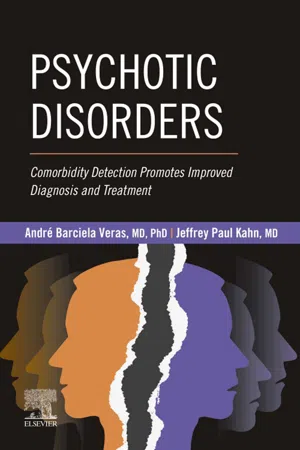Biological Explanations for Schizophrenia
Biological explanations for schizophrenia propose that genetic factors, neurotransmitter imbalances (especially dopamine), and brain abnormalities contribute to the development of the disorder. Genetic predisposition is a key factor, with research suggesting that individuals with a family history of schizophrenia are at higher risk. Additionally, abnormalities in brain structure and function, such as enlarged ventricles and reduced gray matter, are commonly observed in individuals with schizophrenia.
7 Key excerpts on "Biological Explanations for Schizophrenia"
- eBook - ePub
- John Stirling, Jonathan Hellewell(Authors)
- 2013(Publication Date)
- Routledge(Publisher)
...There is now good evidence that psychotic symptoms arise because of abnormalities in brain function, as these abnormalities are detectable by both neuropsychological tests and brain-imaging. Attempts to explain the development of schizophrenia purely in terms of disturbed patterns of family communication have generally not been successful. However, expressed emotion (EE) research has shown that the long-term course of illness can be modified both by biological factors (antipsychotic medication) and social factors (less contact with high-EE environments, or intervention to reduce levels of EE among household members). The neuropsychological approach demonstrates that many of the symptoms of schizophrenia can be understood as arising from problems in self-monitoring. Further reading Kalat, J.W. (1998) Biological Psychology, 6th edn, Pacific Grove: Brooks Cole. The standard undergraduate biopsychology text. Beautifully illustrated, easy to read and up-to-date. Chapter 16 covers severe mental illness from the physiological perspective. Gottesman, I.I. (1991) Schizophrenia Genesis, Oxford: Freeman. Easy-to-read review of genetics research in schizophrenia, with many personal anecdotes. 1 See John Stirling's book Cortical Functions (in this series for more information on brain hemispheric specialisation....
- eBook - ePub
- Ronald Chase(Author)
- 2017(Publication Date)
- Routledge(Publisher)
...Science supports none of this. A scientific approach to mental disorders could allow those who struggle with these illnesses to receive full acceptance and the high-quality care that they deserve. 36 The key to understanding, treating, and possibly preventing mental illness is to discover its cause or causes. Therefore, the challenge for biological psychiatry is to find the links between altered genes, biomarkers in the brain, and abnormal behaviors. The task is difficult because even the links between normal genes, normal brain organization, and normal behaviors are not fully understood. And yet, progress is definitely being made. In my opinion, the key to future progress in schizophrenia lies in the microcircuits of the cerebral cortex, for it is there that complex synaptic interactions generate everything from conscious thoughts to limb movements. Even a slight alteration in these microcircuits— whether anatomical, chemical, or electrical—has the potential to produce psychotic behavior. I am not alone in this opinion. Two of the leading researchers in the field of biological psychiatry, Drs. P.J. Harrison of Oxford University and D.R. Weinberger of the National Institute of Mental Health (USA), emphasize the involvement of malfunctioning microcircuits in schizophrenia, The evidence that schizophrenia susceptibility genes affect diverse synaptic processes suggests that it will not be synapses per se but the neural circuits in which they participate which will prove to be the appropriate explanatory level to understand how the genetic influences operate. This is consistent with the view that the disorder is fundamentally one of abnormal information processing at the highest level, and such abnormalities are probably best understood in terms of malfunction of cortical micro circuits...
- eBook - ePub
- P. J. McKenna, P. J. McKenna(Authors)
- 2013(Publication Date)
- Routledge(Publisher)
...For nearly as long a period all progress was held up by the ascendancy of psychodynamic psychiatry in America. A turning point was the discovery of chlorpromazine and other antipsychotic drugs, which pointed plainly to the possibility that at least some of the symptoms of the disorder might be biologically determined. Later, the development of brain imaging gave additional momentum to what was already fast becoming a worldwide renaissance of interest in the biological basis of schizophrenia. Ironically, the making-up of lost time has been most apparent in America. Leaving aside biochemical research and the neurodevelopmental hypothesis, which are given chapters to themselves, the two most productive areas of biological schizophrenia research have been genetics and neuroimaging; these are discussed below. A number of other lines of investigation have been followed that have resulted in only minor, equivocal or contested findings. Probably the most important of these has been the question of whether there is a neuropathology of the disorder, so this is also given a section. Genetics The first study to investigate the apparent tendency of schizophrenia to run in families was undertaken by Rudin (1916), working in Kraepelin’s department. Investigations of the parents, twins, siblings, children, and other relatives of schizophrenic patients have since formed the main output of some of the most distinguished of several generations of schizophrenia researchers. This work has been reviewed and updated many times, first by the daughter of Rudin (Zerbin-Rudin, cited by Slater, 1968); and later by many other authors (for example Kallman, 1938; Slater, 1968; Gottesman and Shields, 1982; McGuffin, 1988; Riley et al., 2003)...
- eBook - ePub
Psychotherapy for People Diagnosed with Schizophrenia
Specific techniques
- Andrew Lotterman(Author)
- 2015(Publication Date)
- Routledge(Publisher)
...1 INTRODUCTION The roles of biology and psychology in people diagnosed with schizophrenia The scope of the clinical problem People given a diagnosis of schizophrenia often suffer from intense agony and loneliness. They may endure cruel emotional pain, and must bear up under tormenting feelings of humiliation, emptiness and despair. Efforts to understand and treat what is labelled “schizophrenia” have drawn from an array of medical specialties: neurology, neurobiology, biochemistry, radiology, physiology, genetics, epidemiology and infectious disease, not to mention psychiatry, learning theory and academic and psychodynamic psychology. Unfortunately, these have had limited clinical benefits, as I will outline below. The field of schizophrenia research is as fragmented as it is crowded. What complicates matters further is that there is probably no single entity of “schizophrenia” but rather a heterogenous group of conditions with varying etiologies and outcomes which are grouped under that term. The emotional toll and social and economic costs of conditions called schizophrenia are enormous. For example, in the United States alone, it affects about 1.1% of the population, about 2.5 million Americans. The human cost is immense. Patients experience debilitating symptoms such as hallucinations, delusions, paranoid ideas, cognitive disorganization, social withdrawal, apathy and emotional flattening. The experience of self is often distorted. Patients feel themselves to be fragmented and helpless. Family and friends lose emotionally meaningful contact with psychotic loved ones and suffer along with the identified patient. Opportunities for emotional, creative and social fulfilment are shattered. The social and economic costs are also profound. As of 2002, in the US alone, the direct and indirect economic costs were estimated to be 62.7 billion dollars per year (McEvoy, 2007), and it is reasonable to assume that today that cost is much higher...
- Amy E. Wenzel(Author)
- 2017(Publication Date)
- SAGE Publications, Inc(Publisher)
...Lauren M. Ellman Lauren M. Ellman Ellman, Lauren M. Shanna Cooper Shanna Cooper Cooper, Shanna Arielle Ered Arielle Ered Ered, Arielle Shannon K. Murphy Shannon K. Murphy Murphy, Shannon K. Seth D. Maxwell Seth D. Maxwell Maxwell, Seth D. Schizophrenia Spectrum and Other Psychotic Disorders: Biological Factors Schizophrenia spectrum and other psychotic disorders: Biological factors 2939 2944 Schizophrenia Spectrum and Other Psychotic Disorders: Biological Factors Schizophrenia has long been considered a disorder with substantial biological contributors. A number of biological risk factors have been identified as being involved in the causes and presentation of the disorder, including genes, hormonal alterations, immune abnormalities, obstetric complications (OCs), and abnormalities in brain structure and function. The following entry highlights some of the most well-known biological contributors to schizophrenia spectrum disorders. Genetics/Heritability Schizophrenia has been found to be highly but not completely heritable, with most evidence suggesting that genetic transmission of risk for the disorder is complex, likely involving more than one gene in combination with environmental risk factors. Support for genetic influences in schizophrenia comes from a number of sources, including family, twin, and adoption studies. Specifically, family studies suggest that the risk for schizophrenia increases based on the degree of genetic relatedness of a family member who has schizophrenia. For example, the rate at which identical (termed monozygotic) twins are diagnosed with schizophrenia (i.e., the concordance rate) has been found to range from 40% to 65%, compared with concordance rates of 0% to 28% among fraternal (termed dizygotic) twins, indicating that the higher the genetic relatedness (close to 100% of shared genes for monozygotic twins), the higher the likelihood of risk for schizophrenia...
- eBook - ePub
- Michael R. Trimble, Mark George(Authors)
- 2010(Publication Date)
- Wiley(Publisher)
...Essentially we may be learning that, with only a few exceptions such as Huntington's disease, there are no genes for mental illness per se, but rather genetic effects that relate to information processing in the brain and subsequent cognitive and behavioural strategies, the endophenotypes, which provide a substrate for the later development of the phenotype. No longer is a statistical relationship between genes and a DSM IV-TR diagnosis being looked for, but rather the relationship between the neurobiological effects of genes and the processes that lead to any particular phenotype. With regards to environmental agents, there is evidence that some schizophrenic patients demonstrate increased early brain damage, either through perinatal or uterine insults. Murray et al. (1985) advocate it would be useful to divide schizophrenia into familial and sporadic cases. The sporadic cases are thus associated with increased ventricular size (highly replicated) and environmental traumas reflective of perinatal damage or early head injury. The genetic predisposition, if strong, will promote the disorder, while, in the presence of a lesser genetic vulnerability, the environmental insult becomes necessary for the full expression of the illness. Where there is no genetic vulnerability, as in, for example, some cases of epilepsy, the cerebral pathology itself directly provokes the schizophrenia-like symptoms. More recent discussion of environmental effects has concerned epigenetic and pharmacological influences. The former should include uterine and neonatal events on cerebral development, synaptogenesis and synaptic pruning, as well as early psychosocial stressors (Parent and Meaney, 2008). Alternative environmental insults have been sought, in particular neurological conditions, head injury or infection, for example with viruses. However, recent research has centred on the use of psychoactive drugs, especially cannabis...
- eBook - ePub
Psychotic Disorders - E-Book
Comorbidity Detection Promotes Improved Diagnosis And Treatment
- André Barciela Veras, Jeffrey P. Kahn(Authors)
- 2020(Publication Date)
- Saunders(Publisher)
...Chapter 2: Psychotogenesis Nadia Rahman; Sulaima Daboul; Emeka Boka; Dolores Malaspina Abstract What are the underlying causes of psychosis? Why do certain members of the general population experience hallucinations but remain functional while other members enter the psychosis prodrome, and still others go on to experience full-fledged psychosis? In this chapter we will review the putative risk factors associated with psychosis and explore current theories on the pathogenesis of psychosis. We begin with a brief history of psychosis that reviews schizophrenia and related psychosis disorders. Next, we explore genetic risk factors and environmental exposures for psychosis. We conclude this chapter with an overview of current theories regarding the pathophysiology of psychosis and early predictors of psychosis. Keywords Psychosis; Premorbid; Risk pathways; Schizophrenia; Schizoaffective; Cannabis; Paternal age Introduction As described since ancient times, and by Hippocrates 2000 years ago, psychosis is a mental state characterized by impaired reality testing. 1 It is manifest as a constellation of symptoms, including false perceptions and fixed false beliefs, called “hallucinations” and “delusions,” and through disturbed thinking evidenced by the use of language, including “loose associations,” and frequently through bizarre motor activity and behavior. Schizophrenia is the best-known psychotic disorder, and many of the classic symptoms of psychosis were originally observed in patients who would currently be diagnosed as having schizophrenia. Eugen Bleuler (1857–1939), the Swiss psychiatrist who coined the term “schizophrenia” (from the Greek skhizein “to split” and phren “mind”), considered psychotic symptoms to arise from a “break” (disconnection) between the neural systems subserving thought and emotion...






